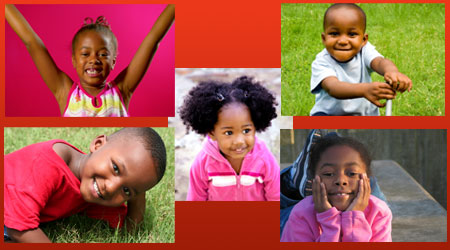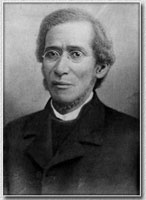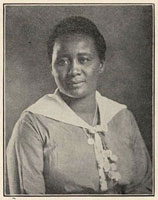|

JESUS AND CHILDREN
(Birth–Age 12)
CULTURAL RESOURCES
Sunday, March 15, 2009
Margarita Simon Guillory, Guest Cultural Resource Commentator
Doctoral Student in African American Religion, Rice University, Houston, TX
I. Historical Moments
Jesus, in today’s scripture, illustrates a relationship based on selfless service, embracing love, and humility. Specifically, these relational characteristics become the focal point of a moment in which Jesus and a child represent the primary participants. A teaching moment occurs. Jesus changes the position of the child. In Jesus’ movement of the child from a peripheral to a central position, the child serves as an illustrative point representing a specific posture, one of selfless servitude—an action without selfish motive that extends beyond the actor. Embracing the child, representing a position of love and protection, Jesus makes a proclamation. This pronouncement further reveals the type of relationship existing between Jesus and this child, in particular, and children in general. Jesus proclaims, “Whoever welcomes one such child in my name welcomes me, and whoever welcomes me welcomes not me but the one who sent me.”
A continual examination by African Americans of Jesus’ attitude of selfless servitude, embracing love, and humility will lead us back to our own community where we can see that these tenants have long operated in regard to children. These qualities come to life in the familial acts of single mothers or fathers working multiple jobs to feed their children; older siblings foregoing their personal plans in order to help rear younger siblings; family units, whether nuclear or extended, working together to provide children with more opportunities.

Not only does this orientation that Jesus establishes with children occur within familial settings, but this same type of positioning can be attested to in African American churches, especially in the area of education. For example, there is the persistence and dedication of Daniel Alexander Payne to educate African American children. Although a well educated man, Payne refused to utilize his formal education to pursue selfish gain; instead, he started a grammar school in Philadelphia. His selfless service to these children provided a spark in the African Methodist Episcopal Church (A.M.E.) and helped advance its involvement in the education of African American children and youth. African American denominations, such as the A.M.E.s, have long been contributors to the stability and resilience of African American children. Legion are the stories of black boys and girls who can testify that in some church, usually one not that large, they learned that “Jesus loves the little children, all the children of the world,” that “Jesus wanted them for a sunbeam,” and that “Jesus loves me this I know, for the Bible tells me so. Little ones to him belong, they are weak, but he is strong. Yes, Jesus Loves me.” But, not only did they learn these faith building, self-esteem enhancing, nurturing songs, they learned the books of the Bible in BTU (Baptist Training Union) or BYPU, how to interact with others through time spent in boy and girl scout troops that met at the church. They learned to revere God and to respect their heritage through black history lessons taught at the church. Sometimes, they quoted and recited the words of Gwendolyn Brooks, Langston Hughes, and Frederick Douglass for Black History Month and in oratorical contests.
II. A Story to Tell
“Everyone has a story to tell,” a phrase often uttered by Mrs. Smith, my ninth grade Language Arts teacher, still resonates deep within the recesses of my mind; and, to this day I find these words of wisdom to be true. Contained within the crevices of experience are specific stances taken when facing trials, tribulations, good times, promotions, death, illnesses, financial gains, and births. Thus, the biography or autobiography allows one to witness different positions taken by individuals in relation to others outside of themselves. For example, Rosa Young’s biography, Light in the Dark Belt, allows one to take a glimpse at the attitude she maintained relative to children.

Rosa Jinsey Young was born May 14, 1890 in Rosebud, Wilcox County (rural Alabama). She was the fourth of ten children. Her father was an Episcopal minister. Like Jesus in Mark 9:33-37, Young always exemplified embrace of and personal commitment to children through her selfless work to teach them. After graduating at the top of her class from Payne University, Young returned to her birthplace of Rosebud, Alabama with one sole objective -- to start a school for this rural community’s children. Having no financial outlet to which she could turn for assistance, Young decided to invest her sole savings “not for praise, glory, or honor,”1 but for the love of children. Young believed that bettering the condition of children superseded personal advancement. She states, “The children, the dear little children of the rural districts, whom I love so well and in whom I am so interested, were in a sad condition.”2 This compassion toward the children of rural Alabama, combined with the selfless sacrifice of her personal finances and time, led to the opening of a small school, Rosebud Literary and Industrial School, in 1912. For the next three years, Young sought support for the school from people such as Booker T. Washington and denominations such as the Lutheran Church. As a result of Young’s unyielding sacrifice, driven by personal commitment and compassion, the Rosebud School, by 1915, housed more than two hundred students. The support she received from the Lutherans led her to partner with them and, eventually, she became a Lutheran convert and, eventually, an instructor at Concordia College training black Lutheran pastors.
Fill in the Name
On this Sunday, why not celebrate, in some way, all of the Rosa Youngs you know who have embraced children and helped them soar to greater heights. The following list, which you should add to, could be placed inside your church bulletin, used in classrooms, or made part of other teaching activities as you encourage the adults in your church to embrace children:
- Mother Clara Hale of New York - Caretaker of babies of drug-addicted parents
- Marian Wright Edleman – Founder and Director, The Children’s Defense Fund
- Alonzo Washington – Fights to get media attention placed on missing black children
- Tonya Bolden - Author of books about black children
- Evelyn K. Moore - Executive director of the National Black Child Development Institute
- George H. Clements – Began One Church, One Child National Black Adoption Program
Again, ask persons in your church or community to offer names to add to the list.
III. Poetry for this Lectionary Moment
At times, poetry maintains a straightforward personality while, at other times, it operates in a sneaky manner, wrapping itself in layers and layers of difficult language. Regardless of its form, it has a way of displaying--a lot like biography--activities, emotions, and experiences of life. Accordingly, this lection turns to poetry in order to view a display of God’s compassion and steadfastness in the formation of a child.
Ain’t No Lights in the Womb
The womb is a dark place filled with the unknown.
It’s a place where life takes cover.
You see, this place is the holding area for God’s children.
Ain’t No Lights in the Womb
There, in this secret place, God creates.
Handmade not manufactured.
God uses his hands to personally knit each child.
Different shapes, textures, and shades.
The forming child does not put up a fight,
But is at peace knowing—
Knowing the Creator.
Ain’t No Lights in the Womb
God forms without ceasing and without lights.
See. God does some of the most amazing things at night.
Free of distractions
God knits.
Eyes and ears, toes and fingers.
Committed. God knits.
noses and mouths.
Steadfast. God knits.
the very heart of the child!
Completed.
Light.3
IV. Resources (Books for Ages 5-11)
The following books are great resources for use by Christian education departments, schools and other organizations that serve children.
1. Young, Rosa. Light in the Dark Belt: The Story of Rosa Young as Told by Herself. St. Louis, MO: Concordia Publishing House, 1929.
|
2. King, Wilma. African American Childhoods: Historical Perspectives from Slavery to Civil Rights. New York, NY: Palgrave Macmillan, 2005.
|
3. Bolden, Tonya.Tell All the Children Our Story: Memories and Mementos of Being Young and Black in America. New York, NY: Abrams, 2001. The book covers children's lives in America from the 1600s to the present.
| 
|
4.
Haywood, Rolling James. Come Look with Me: Discovering African American Art for Children. Waltertown, MA: Charlesbridge Publishing , 2005.
| 
|
5. Sanders, Nancy I., and E. B. Lewis (Illustrator). D Is for Drinking Gourd: An African American Alphabet (Discover the World). Farmington Hills, IL: Sleeping Bear Press, 2007.
| 
|
6. Perdomo, Willie, and Bryan Collier (Illustrator). Visiting Langston. New York, NY: Henry Holt and Co. BYR Paperbacks, 2005.
| 
|
7. Nave, Jeff. Obama's Pajamas. Bloomington, IN: AuthorHouse, 2008.
| 
|
8. Giovanni, Nikki. Hip Hop Speaks to Children: A Celebration of Poetry with a Beat. Naperville, IL: Sourcebooks Jabberwocky, 2008.
| 
|
9. Hopkinson, Deborah, and James E. Ransome (Illustrator). Sweet Clara and the Freedom Quilt. New York, NY: Knopf Books for Young Readers, 2003.
| 
|
V. Songs for this Lectionary Moment
Songs, like biographies and poetry, serve as a space in which the notations of life resonate in a lyrical format. A display of Jesus’ love and compassion for all children manifests itself in the first song, “Jesus Loves the Children of the World.” This exposition of affection extends beyond the social construction of ethnicity. All children are afforded a place, much like the little child found in Mark 9:36, in the loving arms of Jesus.
Jesus Loves the Little Children
Jesus loves the little children,
All the children of world;
Red and yellow, black and white,
They are precious in his sight;
Jesus loves the little children of the world.4
The song, “Jesus Loves Me,” makes patently clear the simple faith of a child who believes in Christ. However, this song for children should also be the testimony of believers of every age—Jesus loves me.
Jesus Loves Me
Jesus loves me , this I know, For the Bible tells me so.
Little ones to him belong, They are weak but he is strong.
Yes, Jesus loves me, Yes, Jesus loves me,
Yes, Jesus loves me, The Bible tells me so.
Jesus loves me, he who died, Heaven's gates to open wide,
He will wash away my sin, Let his little child come in.5
The final song, “What About the Children,” is one that expresses the ugliness of life children face
and implores adults to embrace children in love, as Jesus did.
What About The Children
Tears streaming down, her heart is broken
Because her life is hurting, so am I
He wears a frown, his dreams are choking
And because he stands alone, his dreams will die
So, humbly I come to you and say
As I sound aloud the warfare of today
Hear me, I pray
Chorus
What about the children
To ignore is so easy
So many innocent children would choose the wrong way
So what about the children
Remember when we were children
And if not for those who loved us and who cared enough to show us
Where would we be today
Sir, where is your son
Where lies his refuge
And if he can't come to you, then where can he run
Such a foolish girl, yet still, she's your daughter
And if you will just reminisce your days of young
You see, it's not where you've been, nor what you've done
Because I know a friend who specializes in great outcomes
See His love overcomes
Chorus (2 times)
Where would we be today
Where would we be today
Where would we be today
What about the children.6
Notes
1. Young, Rosa. “What Induced Me to Build a School in the Rural District.” In African American History: A Documentary Witness. Milton C. Sernett, Ed. Durham, NC: Duke University Press, 1999. p. 348.
2. Ibid., p. 350.
3. Simon Guillory, Margarita. Ain’t No Lights in the Womb.
4. “Jesus Loves the Little Children.” Christian Methodist Episcopal Church. The Hymnal of the Christian Methodist Episcopal Church. Memphis, TN: CME Publishing House, 1987. p. 470.
5. “Jesus Loves Me This I Know.” African American Heritage Hymnal. Chicago, IL: GIA Publications, 2001. #335
6. The Lyrics to Yolanda Adams’ “What About the Children,” All the Lyrics.com. Online location: http://www.allthelyrics.com accessed 15 December 2008
|